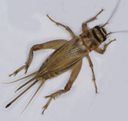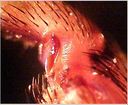Acheta
Acheta
Classification
- Phylum: Arthropoda
- Subphylum: Hexapoda
- Class: Insecta
- Order: Orthoptera
- Suborder: Ensifera
- Infraorder: Gryllidea
- Family: Gryllidae
- Subfamily: Gryllinae
- Genus: Acheta
Pronunciation
How to pronounce Acheta: /əˈkiːtə/
These audio files are automatically generated. While they are not always 100% accurate, they are a good starting point.
Images






Summary
Acheta domesticus, commonly known as the house cricket, is an omnivorous insect that spends much of its life cycle indoors. It has been widely used as a feeder insect and is being approved for use in food products in various regions.
Physical Characteristics
Body 16-21 mm. Head light brown with three black transverse bands; three total bands: one across the back of the head, one between the eyes, and a third horseshoe-shaped band between the antennae. Pronotum light brown with dark markings. Wings brown and black, extending beyond abdomen. Pale dorsolateral line along each wing. Legs brown, hind tibiae with two rows of spines. Ovipositor straight and thin, shorter than length of abdomen.
Identification Tips
Males and females look similar, but females have a longer ovipositor. Males have more prominent cerci at the rear.
Habitat
Found in and around houses, buildings, and in garbage dumps; can be present throughout the year indoors.
Distribution
Wild populations are restricted to the eastern United States (except peninsular Florida), southern Ontario and Quebec, and southern California.
Diet
Omnivorous, consuming soft plant matter, other insects, and carrion. In captivity, eats a variety of fruits, vegetables, grains, and commercial pet foods.
Life Cycle
Takes two to three months to complete life cycle. Eggs are laid in moist substrates. Juveniles resemble adults but are smaller and wingless.
Reproduction
Eggs are deposited in damp substrates such as sand or moss. Overwinters as an adult in sheltered areas.
Economic Impact
Became the standard feeder insect for the pet and research industries between 1950 and 2000. Popular as pets in regions like China and Japan.
Cultural Significance
In Asia, becoming more popular than native cricket species for human consumption.
Health Concerns
Eliminated from cricket-breeding industries in North America and Europe due to cricket paralysis virus, which is lethal to this species.
Collecting Methods
- Traps
- Netting
- Capturing from wild habitats
Preservation Methods
- Freeze-drying
- Dry-roasting
- Powdering
Evolution
Most likely native to Southwestern Asia; spread worldwide.
Similar Taxa
Misconceptions
May be confused with wild crickets, but domesticated and bred for various uses.
Tags
- insect
- cricket
- Acheta
- omnivore
- edible insect